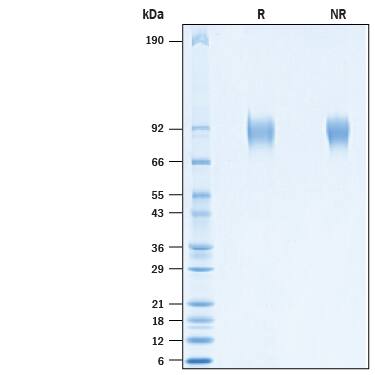Recombinant Cynomolgus Monkey IFN-alpha/beta R1 Protein, CF
R&D Systems, part of Bio-Techne | Catalog # 10674-AB
His-tag

Key Product Details
Product Specifications
Source
Human embryonic kidney cell, HEK293-derived cynomolgus monkey IFN-alpha/beta R1 protein
Ala23-Ile439, with a C-terminal 6-His tag
Ala23-Ile439, with a C-terminal 6-His tag
Purity
>95%, by SDS-PAGE visualized with Silver Staining and quantitative densitometry by Coomassie® Blue Staining.
Endotoxin Level
<0.10 EU per 1 μg of the protein by the LAL method.
N-terminal Sequence Analysis
Ala23 & Gly26
Predicted Molecular Mass
48 kDa
SDS-PAGE
80-100 kDa, under reducing conditions
Activity
Measured by its binding ability in a functional ELISA.
When Recombinan Cynomolgus Monkey IFN‑ alpha/ beta R1 His-tag protein is immobilized at 10 µg/mL (100 µL/well), Recombinant Human IFN-A2 binds with an ED50 of 1-6 μg/mL.
When Recombinan Cynomolgus Monkey IFN‑ alpha/ beta R1 His-tag protein is immobilized at 10 µg/mL (100 µL/well), Recombinant Human IFN-A2 binds with an ED50 of 1-6 μg/mL.
Scientific Data Images for Recombinant Cynomolgus Monkey IFN-alpha/beta R1 Protein, CF
Recombinant Cynomolgus Monkey IFN-alpha/beta R1 Protein Binding Activity.
When Recombinant Cynomolgus Monkey IFN‑ alpha/ beta R1 His-tags protein is immobilized at 10 µg/mL (100 µL/well), Recombinant Human IFN-A2 binds with an ED50 of 1-6 ug/mL.Recombinant Cynomolgus Monkey IFN-alpha/beta R1 Protein SDS-PAGE.
2 μg/lane of Recombinant Cynomolgus Monkey IFN-alpha/beta R1 Protein, CF (Catalog # 10674-AB) was resolved with SDS-PAGE under reducing (R) and non-reducing (NR) conditions and visualized by Coomassie® Blue staining, showing bands at 80-100 kDa.Formulation, Preparation and Storage
10674-AB
| Formulation | Lyophilized from a 0.2 μm filtered solution in PBS with Trehalose. |
| Reconstitution | Reconstitute at 500 μg/mL in PBS. |
| Shipping | The product is shipped at ambient temperature. Upon receipt, store it immediately at the temperature recommended below. |
| Stability & Storage | Use a manual defrost freezer and avoid repeated freeze-thaw cycles.
|
Background: IFN-alpha/beta R1
References
- Langer, J.A. et al. (2004) Cytokine Growth Factor Rev. 15:33.
- Uze, G. et al. (1990) Cell 60:225.
- Hwang, S.Y. et al. (1995) Proc. Natl. Acad. Sci. USA 92:11284.
- Takaoka, A. et al. (2000) Science 288:2357.
- Lamken, P. et al. (2004) J. Mol. Biol. 341:303.
- Arduini, R.M. et al. (1999) Prot. Sci. 8:1867.
- Kalie, E. et al. (2008) J. Biol. Chem. 283:32925.
- Platanias, L.C. (2005) Nat. Rev. Immunol. 5:375.
- Claudinon, J. et al. (2009) J. Biol. Chem. 284:24328.
- Zheng, H. et al. (2011) Blood 118:4003.
- Qian, J. et al. (2011) PLoS Pathogens 7:e1002065.
- Bhattacharya, S. et al. (2010) J. Biol. Chem. 285:2318.
- Bhattacharya, S. et al. (2011) J. Biol. Chem. 286:22069.
Long Name
Interferon alpha/beta Receptor 1
Alternate Names
IFN-aR1, IFN-bR1, IFNAR1, IFNbR1
Gene Symbol
IFNAR1
UniProt
Additional IFN-alpha/beta R1 Products
Product Documents for Recombinant Cynomolgus Monkey IFN-alpha/beta R1 Protein, CF
Product Specific Notices for Recombinant Cynomolgus Monkey IFN-alpha/beta R1 Protein, CF
For research use only
